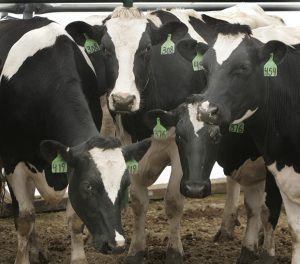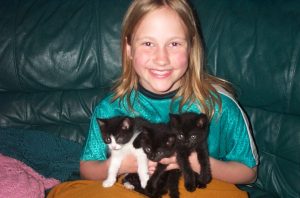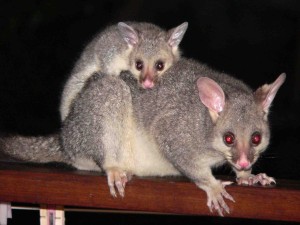Why go to school when you can play hockey?
Tag Archives: Queensland
Doctors issue warning after rise in Salmonella
To commemorate Australia Day (Jan.26), or Invasion Day as some prefer to call it, medical types in my home state of Queensland have warned of an unexplained spike in Salmonella cases.
 Doctor Ryan Harvey said with extreme heat conditions forecast to stay, it was imperative people considered how their food was stored and prepared.
Doctor Ryan Harvey said with extreme heat conditions forecast to stay, it was imperative people considered how their food was stored and prepared.
“Food poisoning and illnesses such as Salmonella can not only be incredibly uncomfortable – they can also be dangerous,” Dr Harvey said.
Federal Government statistics show the number of salmonella cases in Australia has increased significantly over the past 20 years and Australia has one of the highest rates of foodborne illness.
Shiga-toxin E. coli in dairy cattle near Brisbane
Sure it’s almost 20 years old. But a reminder.
 Over a 12-month period, 588 cattle faecal samples and 147 farm environmental samples from three dairy farms in southeast Queensland were examined for the presence of Shiga-toxigenic Escherichia coli (STEC). Samples were screened for Shiga toxin gene (stx) using PCR.
Over a 12-month period, 588 cattle faecal samples and 147 farm environmental samples from three dairy farms in southeast Queensland were examined for the presence of Shiga-toxigenic Escherichia coli (STEC). Samples were screened for Shiga toxin gene (stx) using PCR.
Samples positive for stx were filtered onto hydrophobic grid membrane filters and STEC identified and isolated using colony hybridisation with a stx-specific DNA probe. Serotyping was performed to identify serogroups commonly associated with human infection or enterohaemorrhagic Escherichia coli (EHEC). Shiga-toxigenic Escherichia coli were isolated from 16.7% of cattle faecal samples and 4.1% of environmental samples. Of cattle STEC isolates, 10.2% serotyped as E. coli O26:H11 and 11.2% serotyped as E. coli O157:H7, and the E. coli O26:H11 and E. coli O157:H7 prevalences in the cattle samples were 1.7 and 1.9%, respectively.
Prevalences for STEC and EHEC in dairy cattle faeces were similar to those derived in surveys within the northern and southern hemispheres. Calves at weaning were identified as the cattle group most likely to be shedding STEC, E. coli O26 or E. coli O157. In concurrence with previous studies, it appears that cattle, and in particular 1-14-week-old weanling calves, are the primary reservoir for STEC and EHEC on the dairy farm.
A longitudinal study of Shiga-toxigenic Escherichia coli (STEC) prevalence in three Australian diary herds
Veterinary microbiology, Volume 71, Issue 1-2, Pages 125-37, Jan 1, 2000
Vets test for deadly cat virus in Queensland after multiple deaths
My science writing career started with cats.
 (The two black ones made it to Kasnas, the other one, Lucky, wasn’t so lucky)
(The two black ones made it to Kasnas, the other one, Lucky, wasn’t so lucky)
My parents didn’t allow warm-blooded mammals in the house, just Salmonella-ridden turtles, so when my ex brought me 2 kittens from the vet clinic where she was a student, it still stands out as the nicest thing she ever did for me.
I wrote about cat behaviour, weekly, because I was fascinated and thought everyone else would be.
Maybe not, but I was editor-in-chief the next year, because of no bullshit and cats.
The ex wrote a book no one read except my former hockey team mates in which she stated the only thing I was good for was throwing off good-looking daughters.
Duh.
And people wonder why I have angst.
Calicivirus is when I got turned on to leaning.
A fourth-year virology class, we kids had to go do an independent project, and I chose Calicivirus.
Just woke me up to all the things that were available to learn, other than cats.
The Courier-Mail reports urgent testing is underway to determine the cause of death of a number of cats in south-east Queensland in the past month, with vets suspecting a particular strain of virus to be responsible.
In recent weeks there have been possibly 14 cases of Feline Calicivirus-Virulent Systemic Disease, or Virulent Calicivirus, reported in Queensland.Of those 14 cases – all but one have come from the Ipswich area, west of Brisbane.
Australian Small Animal Veterinarians President Dr Mark Kelman said laboratory testing was underway in Sydney.
“At this stage we’re not 100 per cent sure it’s this cat virus that’s going on. It’s still early days,” Dr Kelman said.
“It’s highly suspicious that it may be what we call Feline Calicivirus-Virulent Systemic Disease … it’s not common at all.
“If it is that it’s a variant of a fairly common virus which is the Feline Calicivirus but this particular strain causes more severe disease in cats and certainly can be fatal.”
Dr Kelman said he hoped to have a definitive answer within the next week.
Swollen legs a concerning symptom for cats
Three cats from the Ipswich area have died and others have been euthanised because of the severity of their symptoms, Dr Kelman said.
We’re all hosts on a viral planet.
Possums, birds and tank water in Queensland: A microbial risk
As Australians begin the workweek with a hung parliament after yet another federal election, I aptly turn my attention to the politicians of the rodent world: possums.
 The Australian climate can be harsh, in a No-Country-for-Old-Men sorta way, with temperature extremes, flooding, followed by five years of drought.
The Australian climate can be harsh, in a No-Country-for-Old-Men sorta way, with temperature extremes, flooding, followed by five years of drought.
So we have new-fangled rain barrels that my grandparents used to have in Ontario (ours, right, exactly as shown and I know there’s possums wandering around there at night because possum poop accumulates).
The rainwater is supposed to be used for toilets, dishes, laundry and other non-potable uses, but is there a risk (no drinking from the garden hose here)?
Here’s the most recent from researchers:
Avian and possum fecal droppings may negatively impact roof-harvested rainwater (RHRW) water quality due to the presence of zoonotic pathogens. This study was aimed at evaluating the performance characteristics of a possum feces-associated (PSM) marker by screening 210 fecal and wastewater samples from possums (n = 20) and a range of nonpossum hosts (n = 190) in Southeast Queensland, Australia.
The host sensitivity and specificity of the PSM marker were 0.90 and 0.95 (maximum value, 1.00), respectively. The mean concentrations of the GFD marker in possum fecal DNA samples (8.8 × 107 gene copies per g of feces) were two orders of magnitude higher than those in the nonpossum fecal DNA samples (5.0 × 105 gene copies per g of feces). The host sensitivity, specificity, and concentrations of the avian feces-associated GFD marker were reported in our recent study (W. Ahmed, V. J. Harwood, K. Nguyen, S. Young, K. Hamilton, and S. Toze, Water Res 88:613–622, 2016, http://dx.doi.org/10.1016/j.watres.2015.10.050). The utility of the GFD and PSM markers was evaluated by testing a large number of tank water samples (n = 134) from the Brisbane and Currumbin areas. GFD and PSM markers were detected in 39 of 134 (29%) and 11 of 134 (8%) tank water samples, respectively. The GFD marker concentrations in PCR-positive samples ranged from 3.7 × 102 to 8.5 × 105 gene copies per liter, whereas the concentrations of the PSM marker ranged from 2.0 × 103 to 6.8 × 103 gene copies per liter of water. The results of this study suggest the presence of fecal contamination in tank water samples from avian and possum hosts.
 This study has established an association between the degradation of microbial tank water quality and avian and possum feces. Based on the results, we recommend disinfection of tank water, especially for tanks designated for potable use.
This study has established an association between the degradation of microbial tank water quality and avian and possum feces. Based on the results, we recommend disinfection of tank water, especially for tanks designated for potable use.
Importance
The use of roof-harvested rainwater (RHRW) for domestic purposes is a globally accepted practice. The presence of pathogens in rainwater tanks has been reported by several studies, supporting the necessity for the management of potential health risks. The sources of fecal pollution in rainwater tanks are unknown. However, the application of microbial source tracking (MST) markers has the potential to identify the sources of fecal contamination in a rainwater tank. In this study, we provide evidence of avian and possum fecal contamination in tank water samples using molecular markers. This study established a potential link between the degradation of the microbial quality of tank water and avian and possum feces.
Evidence of avian and possum fecal contamination in rainwater tanks as determined by microbial source tracking approaches
Ahmed a, K. A. Hamilton a,b, P. Gyawali a,c, S. Toze a,c and C. N. Haas b
A CSIRO Land and Water, Ecosciences Precinct, Brisbane, Queensland, Australia
B Drexel University, Philadelphia, Pennsylvania, USA
C School of Public Health, University of Queensland, Herston, Queensland, Australia
Applied and Environmental Microbiology, Volume 82, Number 14, Pages 4379-4386, doi:10.1128/AEM.00892-16
Australian police discover pig eating cannabis plants during drugs raid
Police say they are on the lookout for any high flying pigs after they found a feral pig eating a cannabis plant near Toowoomba last week.
 They first attended a house at Meringandan West last Wednesday where they saw a man inside an enclosed pen, upon closer inspection they also found a large pig eating what they described as a “green leafy material”.
They first attended a house at Meringandan West last Wednesday where they saw a man inside an enclosed pen, upon closer inspection they also found a large pig eating what they described as a “green leafy material”.
Police will allege that they conducted a search of the address and found a 1.6m high cannabis plant along with 140.7 grams of cannabis.
Up to 164 sickened after attending school principal’s conference in Australia
As misguided calls for Aussie-only produce bear fruit, up to164 delegates from across Queensland attending a school principals’ conference at Brisbane’s Convention and Exhibition Centre have been sickened, possibly with Salmonella.
 Check the egg-based dishes (a table of Australian egg-based Salmonella outbreaks is available here).
Check the egg-based dishes (a table of Australian egg-based Salmonella outbreaks is available here).
Twenty-two people so ill they had to be admitted to hospital.
Queensland Health last night confirmed it had launched an investigation.
The Courier-Mail reports that blood tests of one patient indicated salmonella poisoning.
Queensland Teachers Union president Kevin Bates said last night delegates had suffered severe illness.
“The symptoms have been described as vomiting, nausea and severe dehydration,” Mr Bates said.
One sick principal questioned food handling standards.
“All the hot food – curry and rice and so on – was in pretty white bowls without heating. Not a bain-marie in sight,” the principal said.
Queensland Secondary Principals’ Association president Andrew Pierpoint said an email was sent to principals yesterday urging them to contact a doctor if they felt ill.
Queensland Health communicable diseases director Dr Sonya Bennett said the education department had contacted the health office on Sunday afternoon to raise concerns about the number of conference attendees who had fallen ill.
The Brisbane Convention and Exhibition Centre did not return calls yesterday.
At least 80 sick with Salmonella linked to Australia Chinese restaurant
 Chinese restaurant Chin Chin at Springwood was closed by Logan City Council on Monday after people began presenting to hospitals with food poisoning symptoms.
Chinese restaurant Chin Chin at Springwood was closed by Logan City Council on Monday after people began presenting to hospitals with food poisoning symptoms.
A representative of Queensland Health said it was believed most of those sick had eaten at the premises on Saturday and Sunday.
About 80 people are understood to have been affected, but final numbers had yet to be calculated.
A Metro South health spokesman said tests were still being carried out and it was too early to confirm what caused the outbreak.
“As of Wednesday afternoon, we’d received nine formal complaints, but they relate to multiple people,” he said.
“Metro South Public Health is investigating, with samples and statements taken from a number of people.”
In a statement, a Logan City Council spokeswoman said they were working with Queensland Health to investigate.
“We have taken steps under the Food Act 2006 to ensure there is no further risk until the outcome of the investigation is known,” she said.
“We also encourage people would like to report any other alleged cases of illness to contact Queensland Health.”
 Privacy legislation prevented Metro South and the Logan City Council from confirming the name of the eatery.
Privacy legislation prevented Metro South and the Logan City Council from confirming the name of the eatery.
However dozens of angry comments were left on an automatically-generated Facebook page for Chin Chin.
“Went here with three friends on Saturday, one of us has been admitted to hospital for food poisoning (around 30 people there from Saturday night alone!). And I’ve been writhing in pain for the last two days,” wrote Benjamin Gunning.
“Absolute disgrace,” wrote Joshua Curtus.
“My partner and I ate there on [Saturday] and we have been in bed sick for 3 days. This place needs a serious clean up… I will never eat there again.”
Julie Holmes and her daughter Tayla are recovering after falling ill over the weekend. They were at the restaurant to celebrate Julie’s birthday.
Eight of the 15 people at Julie Holmes’ birthday dinner on Sunday night fell violently ill.
A sign on the restaurant’s door yesterday read: “Closed for maintenance until further notice.”
Authorities say the closure order does not necessarily mean the restaurant is to blame for the outbreak because it may have been supplied with contaminated food.
Bullshit. Sourcing food from safe sources is part of a restaurant’s responsibility, along with the usual — and limited — cooking, cleaning, chilling and separating.
Queensland raw milk producers say Victoria reaction to death and 3 HUS cases is ‘knee-jerk’
Moves by the Victorian Government to introduce new laws aimed at preventing people from drinking unpasteurized milk have prompting questions about whether other states will do the same.
 Under the changes being introduced in Victoria, suppliers will forced to either pasteurise the product, or add an agent to make it taste bitter.
Under the changes being introduced in Victoria, suppliers will forced to either pasteurise the product, or add an agent to make it taste bitter.
The changes come after the death of a three-year-old boy earlier this month, after he drank raw milk earlier this month.
Victoria’s Consumer Affairs Minister, Jane Garrett, says the new laws aim to make bath milk undrinkable, by adding an ingredient to make it taste bitter.
“If people do accidentally confuse raw milk with pasteurised milk, they will either be drinking a product that is safe because it’s been pasteurised, or it will have the foulest taste known to human kind and they will not be able to continue drinking it,” she said.
There are less than ten raw milk producers in Queensland, but some are already nervous that similar regulations could be introduced in the Sunshine State.
Following the child’s death in Victoria, Queensland Health came out strongly against the sale of unpasteurised milk.
At the time, Queensland Health’s chief medical officer Dr Jeanette Young said she would like to see big changes in the rules governing ‘bath milk.’
Yesterday a spokesperson for the Queensland Health Minister said the Government’s position had not changed since then.
The state’s producers of unpasteurised milk say there is no need for greater regulation.
Cleopatra’s Bath Milk manager Trevor Mahaffey says the decision in Victoria is a knee-jerk reaction and he doesn’t believe the Queensland Government will follow suit.
He says buyers should be allowed to make their own decisions.
“It’s a shame that the minister down there (in Victoria) hasn’t looked at both sides of the argument and spoken to people from both sides,” he said.
Mr Mahaffey also said it had not been proven the child in Victoria had died as a result of drinking unpasteurised milk.
 But, three other kids developed hemolytic uremic syndrome, a kidney ailment consistent with shiga-toxin producing E. coli.
But, three other kids developed hemolytic uremic syndrome, a kidney ailment consistent with shiga-toxin producing E. coli.
Even more baffling was the comments from Queensland Dairy Farmers Organisation president, Brian Tessman, who says it is up to the government to decide how it legislates around raw milk.
“They need to decide is it an acceptable risk or not and either decide if they should ban it or put a quality assurance system on it,” he said.
“They need to go on the science and I am not a scientist and we don’t have anyone at the QDO with the scientific qualifications needed to make that decision.”
Maybe they should get some. Or shut-up.
Raw egg mayonnaise more of a G20 threat than terrorism
As Brisbane locks down for the G20 meetings this weekend, Queensland’s Chief Health Officer, Jeanette Young, stated this week that she was more concerned about the threat of raw egg mayonnaise than terrorism, with major hospitals primed to take action in the case of a mass food poisoning event.
 “I’m actually a little bit more worried about food poisoning than I am about other incidents, particularly we’ve seen quite a few outbreaks in Queensland over the last few years, mainly due to raw eggs,” Dr Young said.
“I’m actually a little bit more worried about food poisoning than I am about other incidents, particularly we’ve seen quite a few outbreaks in Queensland over the last few years, mainly due to raw eggs,” Dr Young said.
“We have a lot of problems with raw egg mayonnaise and we’ve seen quite a few incidents where hundreds of people have been impacted, so we certainly don’t want that to happen. I think that is a fairly realistic scenario, but very unlikely given the amount of work that’s been done. My personal view is we should all shy away from raw egg mayonnaise at all times,” she said.
Over 7000 dignitaries, foreign delegates and journalists are starting to arrive in Brisbane already in preparation for events leading up to the main G20 summit on Friday and Saturday this week.
 Many of the more high-profile guests will be bringing their own healthcare teams with them with the doctors being accredited by Queensland Health to practice medicine here. In the case of a serious illness or injury, the dignitary will be treated in a Brisbane Hospital.
Many of the more high-profile guests will be bringing their own healthcare teams with them with the doctors being accredited by Queensland Health to practice medicine here. In the case of a serious illness or injury, the dignitary will be treated in a Brisbane Hospital.
I can’t imagine any of them allowing their leaders to eat a raw-egg based dish.
A table of raw egg related outbreaks in Australia is available at https://barfblog.com/wp-content/uploads/2014/03/raw-egg-related-outbreaks-australia-3-3-14.xlsx

